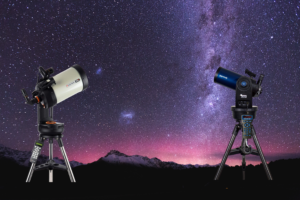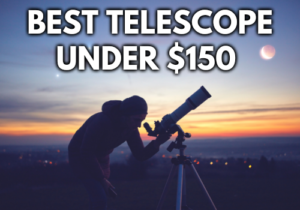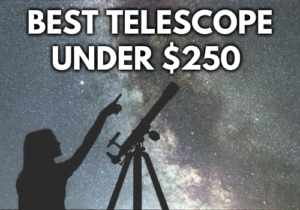7 Best Telescope Eyepieces For All Budgets
Disclosure: This post contains affiliate links and I may earn a small commission (at no extra cost to you) if you click through and make a purchase. Thanks in advance – I really appreciate it!
Most telescopes come with one or two eyepieces which give you one or two magnification options. However, if you want to optimize your viewing experience you’ll need to invest in a better-quality eyepiece.
By having a range of magnifications you can optimize the image, which means you need more eyepieces.
All leading and famous brands of astronomy products manufacturers have their different types of eyepieces.
In this guide, we’re going to help you find some of the best telescope eyepieces and provide you with information that you can use to separate the good from the bad.
Our Top 3 Picks
Best Telescpe Eyepiece Reviews
1. Celestron 8-24mm Zoom Eyepiece
- POWERFUL ZOOM EYEPIECE FOR TELESCOPES: Go from low to high power in an instant with this versatile eyepiece. Zooms to any focal length between 8mm and 24mm. Pick the best magnification for your subject.
- LOW POWER OR HIGH POWER? YOU CHOOSE: Instead of adding lots of expensive fixed focal length eyepieces to your collection, you can buy one eyepiece and experiment with a variety of focal lengths. Spend less time switching eyepieces and more time stargazing!
- WORKS WITH ALL TELESCOPES THAT ACCEPT STANDARD 1.25" EYEPIECES: This versatile zoom eyepiece works with any telescope or spotting scope that accepts 1.25” astronomical eyepieces. It’s also threaded to accept 1.25” filters.
- FULLY MULTI-COATED OPTICS: Every lens surface is coated multiple times with Celestron's unique optical coatings to improve color and contrast and maximize brightness.
- UNBEATABLE WARRANTY & SUPPORT: Buy with confidence from Celestron, a leading telescope brand in California since 1960. Your purchase includes a 2-Year US Warranty and unlimited support from our team of US-based experts.
The Celestron 8-24 mm zoom eyepiece stands out for its versatility and convenience, letting you smoothly adjust focal length from 8 mm (higher magnification) all the way to 24 mm (lower power) without swapping eyepieces.
This makes it especially handy for beginners or casual observers who want to explore different magnification levels when viewing the Moon, planets, or brighter deep-sky objects without investing in multiple fixed-focal-length eyepieces. Its fully multi-coated optics help boost brightness and contrast, and compatibility with any telescope accepting 1.25″ eyepieces adds to its universal appeal.
Users often praise the practicality of the zoom feature in real observing sessions. Instead of fumbling with a box of eyepieces in the dark, you simply twist the barrel to find the view that suits your target and sky conditions, which is a big plus for grab-and-go observing.
The eyepiece also saves money compared to buying a set of individual eyepieces covering the same range, making it a solid choice for those starting their stargazing journey. Cloudy Nights
While it may not match the optical crispness or ultra-wide fields of more expensive fixed eyepieces from premium brands, the overall performance and build quality are well regarded for its price point.
Some experienced observers note that edge sharpness and field of view aren’t as impressive as higher-end alternatives, but many also find the trade-off acceptable given the convenience and range it offers.
In short, it’s a good value, versatile eyepiece for beginners and intermediate hobbyists looking to get more out of their telescope without breaking the bank.
2. SVBONY SV135 Zoom Eyepiece (7–21 mm, 1.25″)
- One eyepiece for multiple uses; this 7-21mm zoom eyepiece allows you to change magnification power without swapping out eyepieces; can be used to view the lunar surface; planets; nebulae; star clusters
- 5-elements 3-groups lens structure; 5-elements 3-groups made of high index glass deliver sharp; high contrast vistas; get bright and true image colors
- 36°-52° field of view; SV135 zoom eyepiece allows you to see different wide field of view under the same viewing conditions
- 13-14mm eye relief; with rubber eyecup; provides comfortable long term viewing for people with or without glasses
- Standard 1.25-inch eyepiece; compatible with 1.25-inch telescopes and accessories; groove anti-drop design; effectively prevents accidental falling during use
The SVBONY SV135 Zoom Eyepiece offers a flexible 7 mm to 21 mm zoom range in a single eyepiece, letting you adjust magnification smoothly without changing lenses, which is highly convenient during night-time observing sessions. This kind of variable focal length makes it suitable for a range of targets — from the Moon’s craters to the belts of Jupiter and Saturn — and simplifies gear for beginners who don’t yet want a full set of fixed-power eyepieces.
Its optical construction with multiple elements and groups aims to deliver clear, high-contrast views throughout the zoom range, and it fits standard 1.25″ focusers on most telescopes.
Users and community reports suggest that, in practice, the SV135 gives good image clarity for its price and holds up reasonably well compared with older, similarly priced zoom eyepieces.
Many find the views crisp enough for general planetary and lunar observing, and the ease of switching magnifications quickly is frequently highlighted as a strong selling point. With comfortable eye relief and decent build quality, it’s a practical choice for hobbyists who want to explore different magnifications without carrying several eyepieces.
That said, compared to premium fixed focal length eyepieces or ultra-wide-field designs, this SVBONY zoom won’t deliver the same level of edge-to-edge sharpness or wide apparent field of view, so experienced observers may eventually want to supplement it with dedicated eyepieces for more critical observing.
Still, for its versatility and value — especially if you’re not ready to invest in a large eyepiece collection — it stands out as a good all-around eyepiece for beginners to intermediates.
3. Celestron X‑Cel LX Eyepiece series (1.25″)
- X-Cel LX eyepieces, optimized for planetary viewing, offer a 60° field of view through a six-element fully multi-coated lens system.
- Pop-up rubber eyeguards provide comfort and increase contrast. Raise and lower with a simple twist.
- A treaded rubber grip offers a no-slip grip, even with gloves on.
- 1.25” barrels are threaded to accept filters.
The X-Cel LX eyepieces from Celestron are widely regarded as a solid upgrade from basic Plössl eyepieces, delivering sharp, high-contrast views with a decent apparent field of view of about 60° thanks to a six-element, fully multi-coated optical design that boosts light transmission and contrast — ideal for both lunar and planetary observing as well as some brighter deep-sky objects. They’re built with features like 16 mm eye relief that’s comfortable for extended sessions and twist-up eyecups that make use easy — even with glasses — plus a rubber grip that helps with handling in the field.
In real-world use, many observers note that these eyepieces strike a great balance of performance and price, especially compared with basic stock eyepieces that come with beginner telescopes.
Community reports often highlight that the optics are comfortable, sharp, and flat across much of the field, with minimal edge astigmatism in the more popular focal lengths like 25 mm, 9 mm, or 7 mm — making them versatile for a variety of targets.
They’re also parfocal, which means you don’t need to refocus much when switching between them, saving time during observing sessions.
That said, the field of view isn’t as wide as premium ultra-wide eyepieces (which often exceed 80°), and some focal lengths in the series aren’t as stellar as others — but for most hobbyists, especially beginners and intermediates, the X-Cel LX line offers very good value: solid optical performance, comfortable ergonomics, and dependable build quality without commanding a premium price.
4. SVBONY SV154 2-inch Super Wide Angle Eyepiece
- Ultra-wide 70-degree field of view eyepiece; especially useful for locating celestial objects and enjoying panoramic views of star fields; nebulae; and other vast phenomena; giving you a beautiful wide angle view for the night sky
- 26mm focal length; this SVBONY telescope eyepiece provides moderate magnification; suitable for a variety of viewing targets; including deep-sky objects such as star clusters and nebulae; as well as lunar and planetary observations
- 5 elements in 3 group lens structure; astronomical telescope lenses are made of high index glass; providing a clear; high-contrast view and delivering crisp; realistic images of the moon; planets; and deep space
- FMC coatings eyepiece; increase light transmission through lens; resulting in brighter images and enhanced contrast and color fidelity of observed images; the wide-angle eyepiece is carefully designed to minimize distortion and aberrations
- 2 inch eyepiece with filter thread; this SV154 eyepiece accepts standard 2-inch filters; fits 2-inch telescopes and astronomy accessories; includes a dust cap to protect the eyepiece lens from damage
The SVBONY wide-angle eyepiece you’re looking at is part of SVBONY’s budget-friendly line of eyepieces that aim to deliver wide fields of view and reasonably crisp optics at an accessible price point.
While exact model specs vary slightly (apparent field usually around 70°+ on similar SVBONY eyepieces), these eyepieces are typically fully multi-coated to improve light transmission and contrast, giving you pleasant views of the Moon, star clusters, and brighter deep-sky objects.
Many users note that the build feels solid for the price and that SVBONY has improved its eyepiece lineup over the years, making them a sensible first upgrade from basic “kit” eyepieces.
In practical use, SVBONY eyepieces in this range generally deliver good image clarity across the center of the field, and the wider apparent field helps make celestial targets feel more immersive compared to narrow-angle Plössls that often come with entry telescopes.
Community feedback on SVBONY eyepieces emphasizes that they are a decent compromise between performance and cost — not premium optics, but certainly capable of showing good detail under dark skies and suitable for beginners to intermediates looking to explore beyond stock eyepieces.
For the money, this SVBONY eyepiece represents good value: it broadens your field of view and gives more comfortable observing than basic eyepieces without breaking the bank.
That said, these budget eyepieces won’t compete with high-end wide-field designs from top optics brands in terms of edge-to-edge sharpness or aberration control. Still, they’re a worthwhile addition for hobbyists upgrading their eyepiece collection, especially if you want a wider view for star clusters and scenic Milky Way views without spending significantly more.
5. Astromania 30 mm 2″ Ultra-Wide Eyepiece
- 80 Degree Ultra Wide Fov Eyepiece: Experience celestial wonders with Astromania's swa 30mm eyepiece; featuring an 80 degree field of view; perfect for deep-space observation with 2" telescopes; it offers 30% wider views than standard eyepieces
- Multi-Layer Coating: Advanced 7 elements in 5 group lens structure minimizes distortion; anti-reflective broadband green film enhances contrast; Scratch-resistant coating ensures long-term performance for telescope eyepieces
- Universal 2" Standard with Filter Compatibility: Industry-standard 2” barrel (51mm) fits most modern telescopes; rear female threading accepts 2" filters & barlow lenses; rugged CNC-machined aluminum construction prevents light leaks
- Extended 22mm Eye Relief for Eyeglass Wearers: Generous 22mm eye-to-lens distance accommodates prescription glasses; twist-up rubber eyecup adjusts for individual comfort; parfocal design maintains focus when switching eyepieces
- Aluminum Alloy Material: This 2 inch telescope eyepiece is made of aluminum alloy and can withstand extreme temperatures; anodized surface resists corrosion & wear; ergonomic rubber eyeguard ensures comfortable stargazing sessions
The Astromania 30 mm eyepiece is a 2″ ultra-wide-angle eyepiece designed to deliver expansive views through larger telescopes. With an 80° apparent field of view, this eyepiece offers significantly broader vistas than standard 2″ eyepieces, making it especially satisfying for observing star clusters, nebulae, and the Milky Way’s rich star fields.
Its fully multi-coated optics and a 7-element in 5-group design help improve light transmission and contrast, giving brighter, more immersive views of deep-sky targets.
In real-world observing, the generous field and comfortable 30 mm focal length make it a great “low-power” eyepiece — ideal for sweeping across large celestial objects and starry regions.
The extended eye relief also makes viewing comfortable, even for eyeglass wearers, and the eyepiece’s robust construction means it feels solid in use. Many users find that its wide field gives a more natural and scenic sky view compared with narrower eyepieces, enhancing visual astronomy sessions.
While it may not match the edge-to-edge sharpness or premium coatings of top-tier eyepieces from leading brands, this Astromania eyepiece offers very good performance for its price — especially as a first dedicated wide-field eyepiece for deep-sky observing.
Its blend of wide field, comfortable ergonomics, and decent optical quality makes it a good value upgrade for beginners and intermediate enthusiasts who want richer, more immersive panoramic views without a big investment.
6. Celestron Luminos 23 mm Eyepiece
- Enjoy wide 82° views with Celestron Luminos Eyepieces
- Retractable eyecup pops up when you need it, drops down when you don’t
- Sturdy anodized aluminum barrels are threaded for filters
- A rubber grip keeps the eyepiece securely in your hands, even when it’s cold or you have gloves on
The Celestron Luminos 23 mm eyepiece is a wide-field eyepiece designed to bring expansive views to your observing sessions. It features an 82° apparent field of view, which is significantly larger than many standard eyepieces and makes sweeping across open star clusters, nebulae, and the Milky Way’s rich star fields much more immersive.
The optics are fully multi-coated and consist of multiple elements to help improve light transmission and contrast, giving bright, pleasing views through your telescope. It also has a retractable eyecup and comfortable eye relief, which make long observing sessions easier on the eyes.
In practical use, many observers find the Luminos eyepiece delivers good detail and a satisfying sense of depth across a variety of targets, from deep-sky objects to expansive lunar vistas.
The parfocal design means switching between eyepieces (if you have more in the same series) requires minimal refocusing, which streamlines observing sessions. Its solid build with a rubber grip and anodized aluminum barrel helps it feel durable in the field — a plus for hobbyists who use their gear often.
That said, while the Luminos line is often praised for its wide fields, some experienced users note that edge-of-field brightness or slight field curvature can be noticeable on certain scopes, especially fast focal-ratio optics, and the large size and weight of the eyepiece may require a sturdy focuser or telescope mount to balance comfortably.
However, for many amateur astronomers looking to upgrade from basic kit eyepieces to something that delivers a more engaging and panoramic sky view, this Luminos eyepiece represents good optical performance and value in its class.
7. Celestron Omni 40 mm Eyepiece 1.25″
- Omni eyepieces offer a quality 4-element Plossl optical design at a super affordable price.
- Rubber eyecups provide comfort and increase contrast. Leave them up or fold them down when wearing eyeglasses.
- Beautiful matte aluminum barrels and blackened lens edges prevent internal reflections.
- 1.25” barrels are threaded to accept filters.
The Celestron Omni 40 mm eyepiece is a classic entry-level Plössl eyepiece that delivers a wide, comfortable view of the night sky with its 40 mm focal length and roughly 43° apparent field of view — ideal for observing large celestial objects such as open star clusters, nebulae, and even sweeping Milky Way star fields. It uses a 4-element optical design with fully multi-coated lenses, which boosts light transmission and contrast for brighter, clearer images through your telescope.
The eyepiece’s rubber eyecup and ergonomic aluminum barrel help make observing sessions comfortable and easy, whether you’re viewing astronomical targets or doing terrestrial observing.
In real-world use, this eyepiece shines as a low-power, wide-field performer that complements higher-power eyepieces in your collection. Its long focal length produces gentle magnification, which is forgiving for beginner astronomers still learning how to locate and track objects in the sky.
Many users appreciate its comfortable eye relief (about 31 mm), which makes it pleasant to look through even during longer sessions, and its solid 1.25″ compatibility means it fits most common telescopes with that size focuser.
While it doesn’t match premium wide-field eyepieces with ultra-wide apparent fields or exotic glass designs, the Omni 40 mm offers very good optical performance and value at its price point — especially for beginners or intermediate users who want a reliable, pleasantly wide view without spending a lot.
The construction and coatings hold up well for visual astronomy, making this eyepiece a useful starter wide-field eyepiece to explore large deep-sky vistas and enhance overall sky-watching enjoyment.
What To Look For In A Good Eyepiece
When stargazing, there are lots of factors that affect your experience; the eyepiece is a key one because it defines the magnification power and field of view of that telescope.
However, finding the right eyepiece is no piece of cake. Below, you’ll find a quick guide with the most important factors you have to take into account when buying your next eyepiece.
Focal Length and Magnification
Focal refers to the length of space it takes the lens to diverge light onto a fixed point. To put it simply, it’s a way to represent the overall optical power that a lens has.
The telescope and eyepiece focal length will determine how much magnification power the overall setup has.
Generally, short focal length eyepieces offer more magnifying power.
Of course, magnification isn’t the only thing that matters when it comes to astronomy and astrophotography.
That’s why it’s good to have several eyepieces on hand.
Barrel Size
To make things simpler, barrel size refers to the physical size of the eyepiece barrel (the silver part that inserts into the eyepiece holder).
Today, there are 3 standard sizes of eyepieces in use for amateur telescopes: .965”, 1.25”, and 2″. The 1.25″ is the most common size of the three used in amateur telescopes.
While the 2″ is also common, this size is generally found on larger, more advanced telescopes.
Apparent Field of View
Commonly called out as AFOV in degrees. This is the calculated angular diameter of light you can see through the eyepiece.
Anything less than 40 degrees is considered narrow and is best suited to observing the planets or the moon. 80 degrees and above is considered wide.
A wide field of view provides a more immersive visual experience, especially for large deep-sky objects.
Eye Relief & Exit Pupil
Eye relief is an entirely different considering factor because it’s completely related to ensuring you the utmost comfort.
Indeed, eye relief means the space between your eyes and the eyepiece. You should get 15mm to 20mm of eye relief for a better and relaxed viewing experience.
The exit pupil is the diameter of the beam of light that projects from the eyepiece into the entrance pupil of your eye.
This is important when you observe the faintest deep-sky objects since you need all the gathered light to be projected onto your retina through your widely dilated pupils.
Conclusion
Ranging from budget-friendly to blow-out-your-budget, these top telescope eyepieces and kits offer you a range of options to upgrade whatever eyepiece came with your telescope originally.
Before purchasing an eyepiece, consider the focal length of your telescope, or telescopes, to make sure the eyepiece will provide an appropriate magnification to suit your needs.
If you wear eyeglasses while using a telescope, pay attention to the eye relief specification of different eyepieces, as ample eye relief can improve comfort and ease of use while wearing corrective lenses.
Written by:

Prakash Chandra
I am a science and technology enthusiast who is curious about emerging concepts in spaceflight, aerospace, and robotics. My passion for astronomy started in my childhood, and my craze for writing started when my works got published in my school's newspaper.
ABOUT US
We are a team of active amateur astronomers, here to help you with all your astronomy and science related needs – this is anything, from reviewing the latest telescopes to be released to talking about gravity and neurons. The Big Bang Optics was started because of our love for astronomy and to help others like us find the best telescope and accessories.
LEGAL DISCLAIMER
The Big Bang Optics is a participant in the Amazon Services LLC Associates Program, an affiliate advertising program designed to provide a means for sites to earn advertising fees by advertising and linking to Amazon.com. The Big Bang Optics also participates in affiliate programs with Clickbank and other sites. The Big Bang Optics is compensated for referring traffic and business to these companies.











